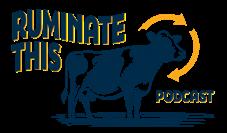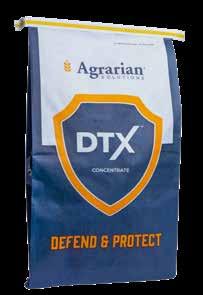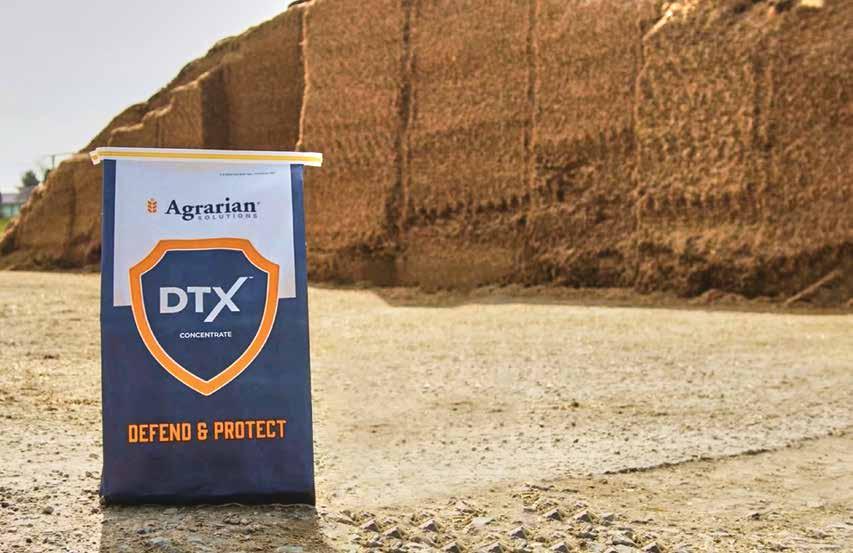

A Letter from Agrarian Solutions
Vice President of Nutrition

Partnership is more than collaboration — it’s the foundation for shared success. Together, we’re building a healthier, more sustainable future for livestock production.
Partnering for the Future
Partnership: An agreement where parties agree to cooperate to advance their mutual interests.
Agrarian Solutions and its team members believe in developing partnerships with our end-customer livestock producers, feed mills, nutrition and veterinary consultants and vendors. Co-operating together we increase the likelihood that each of us accomplishes our goals of financial success, personal growth, technology development and the long-term sustainability of each entity.
Beginning in January 2025, the LivOx™ plant active technology addition to the mycotoxin mitigation strategy (the DTX and BioCycle Plus product families) has resulted in excellent on-farm results for healthier and more productive cattle. The LivOx expertise is the result of our phytogenic partner Phytosynthese, a leading pioneer in plant molecule science. Supplementing LivOx to dairy and beef cattle results in healthier and more productive animals enhancing the economic well-being of their owners.
In July 2025, Agrarian Solutions introduced the Cow Start™ Complete transition bolus to the U.S. dairy industry. The Cow Start Complete transition bolus was researched and developed by Agrarian’s partner Anchor Life Science, and the early on-farm data support the research results of improved health, greater milk production and improved reproductive success. As dairies face a labor shortage, the Done Once/ Done Right™ strategy of two bolus administered at calving is relieving fresh pen labor demands.
Agrarian Solutions’ partnering with Dairyland Labs to provide complimentary mycotoxin assaying to nutritional and veterinary consultants simplifies troubleshooting and improves on-farm economics by determining the correct times to implement a mycotoxin mitigation strategy. Agrarian is also co-operating with consultants to provide data collection and interpretation services.
At Agrarian Solutions, we want to partner with you for the future.
Larry Roth, Ph.D., PAS Vice-president of Nutrition
Q&A with Agrarian Solutions
Q: When did you join the Agrarian Solutions team, and what changes have you seen since then?
A: I joined the Agrarian team in September 2021. There have been so many great changes – adding people to the team, an office move, and business growth, to name a few.
Q: How would you describe the work environment at Agrarian Solutions?
A: Goal-Oriented, Ambitious, both Customer- and Employee-forward
Q: What is your favorite place you’ve visited in the world?
A: Florence, Italy
Q: What are you passionate about outside of work?
A: Spending time with my husband & two daughters, planning my next Disney World trip, reading, being involved in my community & church, watching Survivor & running.
Q: What has been your favorite project to work on at Agrarian Solutions?
A: I really enjoy the year-end and new year projects: lots of reports, reorganization, and resets.
Q: What do you enjoy most about being Office Manager at Agrarian Solutions?
A: I like the variety of the job and problem-solving.


Nic Bradley, Director of Operations

Kelbi Veenstra Office Manager
RISE: The Values That Lift Us Higher
When we began our Entrepreneurial Operating System (EOS) journey in 2021, we set out to clearly define who we are as a company—and who we strive to be. What came out of that process were four simple but powerful words: Relational. Integrity. Strategic. Excellence.
Together, they formed the acronym RISE—and it just felt right. It captured the very essence of Agrarian Solutions. To rise means to move upward, to elevate—and that’s exactly what we aim to do every day: lift up our colleagues, partners, and customers.
Looking back, it’s clear these values weren’t new. They’ve been part of Agrarian’s DNA since the beginning in 1996. RISE has been the common thread through everything we do—the way we build relationships, make decisions, and pursue innovation.
Recently, on the Ruminate This podcast, host Scott Zehr and CEO Mark Carpenter discussed “Shaping the Future of Transition Cow Health.” As I listened, I couldn’t help but hear our values come through: being relational in how we connect with others, leading with integrity, staying strategic in our long-term vision, and pursuing excellence in everything we do.
At Agrarian, these words aren’t just on the wall—they’re how we work, serve, and grow together. Helping others succeed isn’t just what we do. It’s who we are.
Together, we RISE.
Agrarian Solutions Team












Rob Hamaker Vice President, General Manager
Mark Carpenter Chief Executive Officer
Chad Christensen Regional Business Development Manager - West
Dan Hoying National Farm Program Manager
Nic Bradley Director of Operations
Scott Zehr Regional Business Development Manager - East
Cody Cline International Account Manager
Mary Taylor Administrative Assistant
Caroline Knoblock, MSc Director of Nutrition
Kelbi Veenstra Office Manager
Kelly Bristle ALL IN Community Manager
Larry Roth, Ph.D., PAS Vice President of Nutrition

Larry Roth, Ph.D., PAS, Vice President of Nutrition
MYCOTOXIN REPORT: APRIL 1 – SEPTEMBER 30, 2025
Mycotoxin Summary Results
The DON and Zearalenone Challenges Continue
The lingering effects of a challenging 2024 growing season were evident in the mycotoxin summaries across the US for corn silage and TMR samples from April 30, 2025 through September 30, 2025. While DON and zearalenone continue to be the primary mycotoxins in both sample types, Fumonisin is evident in the mid-Atlantic region. The mycotoxin summaries are presented in Table 1 and 2 and Figures 1 and 2 for the 248 corn silage and 354 TMR samples, respectively.
For the past several years, DON and zearalenone contamination have been consistently high for the northeast third of the US for corn silage, and now KS and WI are testing high for DON. North Carolina, Virginia, and Pennsylvania have similar DON concentrations as the last survey, medium to high risk, but fumonisin has increased significantly in corn silage and TMR to the high risk level.
As important as mycotoxin testing is for identifying potential challenges, the confirmation of cow performance and health is the definitive answer on the need for mycotoxin protection. The herd indicators of milk components, manure consistency, health events, and reproduction will indicate how well the cows are handling the mycotoxin load in the feed in addition to other challenge factors they are encountering. Using both the sample results and herd indicators will drive the decision determining the amount of DTX to feed. It is important to note that independent meta-analyses of Kihal et al (2022)¹ suggest that the traditional feed ingredients thought to provide mycotoxin protection are more deleterious at reducing the bioavailability of key nutrients.
Agrarian Solutions provides complimentary mycotoxin testing in feed ingredients and TMR to aid dairy producers and nutritionists in determining the correct amount of DTX is fed to support performance. Contact your Agrarian representative for assistance testing feeds and analyzing test results throughout the year.

Caroline Knoblock, MSc, Director of Nutrition
Collecting feed samples for testing
DON
T-2 Toxin
ppb (parts per billion)
Zearalenone
Fumonisins
T-2 Toxin
ppb (parts per billion)
Zearalenone
Fumonisins
Where Will Agrarian Be During the Next Few Months?








Innovation Looks Like Agrarian
In the 1950s, global shipping was broken. Cargo was loaded one piece at a time—slow, costly, and wasteful. Then a trucker named Malcolm McLean had a simple idea: standard steel boxes. Ordinary on the outside. Revolutionary in impact.
That’s how innovation usually works. It doesn’t look flashy. It looks practical—almost boring—until it changes everything.
39: How LivOx Boosts Gut Health, Liver Function, and Milk Production in Dairy Cows
00:00 | 32.52
In Episode 39, Dr. Larry Roth and I dug into LivOx, the plant-active enhancement to DTX™. Curcumin, naringin, and carnosic acid aren’t buzzwords, but they reduce inflammation, protect the liver, and strengthen the gut. The payoff? More milk, better fertility, faster recovery. Quiet innovation. Big results.
47: Invest in Yourself: The Power of YDLI 00:00 | 23:24
Not all innovation happens in the barn. Sometimes it happens in the people who lead it. In Episode 47, I sat down with Jodi Hoynoski from the Holstein Foundation to talk about the Young Dairy Leaders Institute (YDLI). YDLI develops the next generation of dairy leaders by focusing on communication, relationships, and personal growth. The real magic is networking—connections that last a lifetime and skills that carry through entire careers. Two of us at Agrarian, myself and Caroline Knoblock, are proud YDLI alumni, and the program reflects Agrarian’s RISE core values: relationships, integrity, strategic, and excellence. If you’re between 22 and 40, YDLI is one of the best investments you can make in yourself and in the future of dairy.
54: The next generation of transition cow care 00:00 | 52:37
In Episode 54, we explored Cow Start Complete. Calcium boluses have been the default for decades. They help with milk fever, but they don’t improve fertility or longterm health. The real enemy is inflammation. Cow Start Complete is the Next Generation of Transition boluses. With a sustained 48-hour calcium release and providing 74 micronutrients essential to fighting inflammation, the
result is healthier cows, better body condition, improved reproductive success, and more milk in the tank. Innovation “done once, done right” at calving.
56: Shaping the Future of Transition Cow Health
00:00 | 39:37
In Episode 56, CEO Mark Carpenter explained why Agrarian walked away from a popular calcium-only bolus. It was selling. It was easy. But it wasn’t right. Innovation with integrity means moving beyond “good enough” to deliver what cows actually need.
57: The True Cost of Staying the Same on Your Dairy 00:00 | 35.24
And in Episode 57, Jeff and I tackled the pain of change. Yes, it hurts—new protocols, retraining, up-front investment. But the pain of staying the same? That’s worse. Lost milk, poor reproduction, and higher culls. Every dairy operation pays for pain. The question is whether it’s a temporary investment in pain, or a longterm quiet draining of profits.
Innovation isn’t always wrapped in chrome. Sometimes it looks like a steel box. Sometimes it looks like a bolus. Sometimes it looks like a feed additive. Sometimes it looks like investing in the next generation of leaders.
It may not look flashy. but make no mistake: innovation looks like Agrarian.
New Episodes Every Other Monday!







Larry Roth, Ph.D., PAS, Vice President of Nutrition

Caroline Knoblock, MSc, Director of Nutrition
Emerging Mycotoxin Risks in Wheat Straw and Their Impact on Dry Cows
Mycotoxin risks for dry cows
Emerging mycotoxin trends in wheat straw have put a new focus on the impact of mycotoxins on dry cows. The purpose of the closeup period is to prepare cows for a successful calving transition free from health disorders. Cows that transition well do not experience health disorders and increase feed intake and milk yield quickly after calving.
The 2025 wheat harvest in some areas of the US saw an increase in DON and Zearalenone in the wheat grain and wheat straw. Based on decades of experience, Agrarian Solutions cautions the use of mycotoxin-contaminated wheat straw without mycotoxin protection.
Transition cows can be uniquely vulnerable to mycotoxin exposure. Physiologically her body is managing a tremendous load: growing the fetus, preparing for parturition, and creating colostrum. The cow may also be dealing with environmental stressors such as heat, overcrowding, or water hygiene issues. Adding mycotoxins to the inflammatory load, even without environmental stressors, can be enough to tip her over the edge. Anything that causes inflammation and pulls nutrients away from other purposes adds stress to the cow and makes it more difficult to deal with normal calving related inflammation.
An additional concern is the impact Zearalenone has on dry cows when they enter lactation. Zearalenone is an estrogenic mycotoxin. Zearalenone mimics estrogen and binds to estrogen receptors. During the dry period, dairy cows tend to increase in body condition. When zearalenone is present in the diet and the cow lacks
mycotoxin protection, she will absorb the zearalenone and store it in body fat reserves. Excess zearalenone is stored in body fat due to its cellular structure and similarities in estrogen. Zearalenone is fat soluble, and continuous exposure can result in fat storage. Fat mobilization after calving results in the release of zearalenone into the blood stream. No feed additive can prevent this exposure route; we must prevent Zearalenone absorption during the dry period. Signs of Zearalenone exposure due to body fat release after calving can be a delay in returning to cyclicity and liver damage. Farms may see a slow, sneaky rise in the number of cows with ketosis after calving due to the liver damage caused by zearalenone.
Wheat straw harvested in 2025 averaged 97 ppb Zearalenone, but the range was 0-692ppb. It is important to test straw that will be fed to dry dairy cows. The best strategy is taking core samples from approximately 10% of all bales and compiling the samples. Consider how straw is stored over the winter. If bales are exposed to weather conditions and moisture it is likely that molds and mycotoxins will increase during storage. If bales were exposed to weather conditions over the winter, sample again in the spring. It is important to know the concentration of mycotoxins dry dairy cows are exposed to so we can protect them from mycotoxin related inflammation and enable a successful calving transition.
We must prevent mycotoxin absorption during the dry period and enable cows to transition successfully. The cow faces a serious test after calving; if she fails this test she will not remain in the herd. We should take mycotoxins off the table using DTX to enable a successful calving transition.
Wheat Straw Mycotoxin Concentration

Larry Roth, Ph.D., PAS, Vice President of Nutrition

Caroline Knoblock, MSc, Director of Nutrition
Southern Corn Rust – What to Expect at Feed Out
Southern corn rust is a fungal disease that has been spreading north through cornfields in the United States and has been especially prevalent in the Midwest this year. This fungus does not directly create mycotoxins, rather it reduces plant health and may set the conditions for mycotoxin-causing molds to proliferate in the field or in storage. If freshly chopped corn silage was low in mycotoxins entering storage and fermentation, there is still concern about mold growth and mycotoxin production in storage due to poor fermentation. High moisture corn and dry corn may also be at risk of increased mycotoxin contamination.
Be particularly cautious with corn plants affected by southern rust this year. Put simply, southern corn rust causes the corn plant to dry down unnaturally. The membrane through which nutrients and moisture transfers from the whole plant to the kernel dies early, before kernels reach physiological maturity. Consequently, the grain does not reach full maturity, or black layer, because of a lack of nutrients and will be high in moisture and low in starch and protein. Plants with the immature kernels also have leaves quickly drying down and falling from the plant. After the grain, the leaves are the next most nutrient dense plant part. While waiting for whole plant moisture to drop to enable corn silage harvest the plants likely lost leaves and nutritive value. Dry leaves will negatively impact on how well the corn silage was packed, making it more difficult to pack well and remove oxygen. Be prepared for mold growth and mycotoxin production in storage if the plant experienced southern corn rust; there may have been opportunity for excess oxygen to remain in the pile because of dry leaf material. Plants affected by southern corn rust also have lower sugar content which may lead to poor fermentation.
Corn that was harvested for grain may be left in the field longer than normal while waiting for kernels to dry down. This exposes the plant to weather that creates the perfect environment for the mold that creates DON to proliferate. Fusarium molds grow well in cool and wet environments. High moisture corn and dry corn may be at risk for mycotoxins this harvest season.
If the corn silage was not sampled going into storage, we should prepare for mycotoxin contamination surprises as the feed comes out of storage. When preparing to feed 2025 corn silage, sample as early as possible and develop a mycotoxin protection plan according to the mycotoxin profile. Contact your Agrarian representative for assistance with complimentary sampling and adopting a mycotoxin mitigation strategy. Using DTX when mycotoxins are present in the TMR will help protect cows from mycotoxin related inflammation and keep nutrients partitioned where we want them – milk, growth, and reproduction.


If southern corn rust was present in your fields, prepare for mycotoxin surprises coming out of storage — sample early and protect with DTX.
Puccinia polysora pustules visible on a corn leaf

Larry Roth, Ph.D., PAS, Vice President of Nutrition

Caroline Knoblock, MSc, Director of Nutrition
What Mycotoxin Level is Too High?
The TMR assay results from your mycotoxin testing lab arrive in your inbox, and the mycotoxin levels are across the range. Should you be concerned about the mycotoxin levels and what is the appropriate course of action? What factors besides mycotoxin levels should be considered before determining a mycotoxin mitigation response? The Agrarian Solutions’ philosophy is to evaluate the mycotoxin assay results alongside several other considerations.
Laboratory mycotoxin assay results
The chart below lists low, medium, and high ranges for potential reactions to common mycotoxins. The mycotoxin assay results for a particular feed sample may be influenced by feed variability and accuracy of sampling. The assay reports generated by Dairyland Labs for Agrarian Solutions feature a bar graph depicting that sample’s ranking in low-, mid-, and high-percentiles for that feed type’s historical mycotoxin results. It is important to note that the bar graph is simply a historical ranking and does not indicate the relative risk of feeding the TMR or ingredient as there are important herd indicators that determine the actual mycotoxin reaction.
Environmental and behavior considerations
Variable weather and temperature extremes challenge animal immune systems and trigger physiological responses that may increase the likelihood of a negative mycotoxin reaction. Further, transportation, overcrowding, and other behavioral situations weaken an animal’s resistance to mycotoxins.
Occurrence of multiple mycotoxins
Multiple mycotoxins at a medium risk level may still indicate a high risk TMR because of the different modes-of-action attacking the animal. A combination of mycotoxins with a myriad of challenges to an animal’s immune system increases susceptibility to other health challenges, as well.
“What the cows are telling us”
The feeding rate of Agrarian’s U.S. mycotoxin-mitigation product DTX™ Concentrate can be adjusted based on the above factors or herd indicators. However, the most important feeding rate factor is animal performance and health. An increased incidence of transition health issues, reduced reproductive success, variable manure, or elevated SCC are all key clues that the cows are experiencing mycotoxin-related inflammation and need protection with DTX Concentrate, as evidenced by controlled-research studies and nutritionists’ comments over 25-plus years of field usage.
Animal physiological status and production level
Faster growing and more productive animals are more susceptible to mycotoxin challenges than those at a maintenance stage. In addition, newly weaned calves and newly freshened cows are at a greater risk of a negative mycotoxin reaction than those animals at a stable stage of life. Reproductive success is also at risk to mycotoxin exposure.
Agrarian Solutions recommends testing pre-fresh and lactating cow TMRs regularly, with the frequency determined by how quickly the farm is moving through the feedstuffs, ingredient variability, mycotoxin incidence, and herd indicators. Your clients and you can be confident in the peer-reviewed research and 25-plus years of industry experience that DTX Concentrate will enhance natural defenses, protect tight junctions, and support liver health. Contact us for assistance with feed sampling, mycotoxin risk levels, and DTX Concentrate feeding rate adjustments.
Table 1. Approximate

DTX™ Concentrate is a direct-fed microbial designed to tackle feed challenges from molds and their metabolites.
Utilizing a unique L-form bacteria component ensures maximum effectiveness in improving herd health and productivity.

28.6% Improved Pregnancy Rates
Artificial insemination pregnancy rates from Control 36.7% to DTX™ 47.2%
15.6% Improved ET Pregnancy Rates
Embryo transfer pregnancy rates from Control 27.6% to DTX™ 31.9%
Increased 2.5lb/Cow
Daily milk production for the first 150 DIM
BROAD SPECTRUM. MULTIPLE BENEFITS. View report at www.agrariansolutions.com/dtx
585 Shawnee Street Nappanee, IN 46550 Contact
(574) 825-1224
office@agrsol.com agrariansolutions.com
AgrarianSolutions
AgrarianSolutions agrarian-solutions

